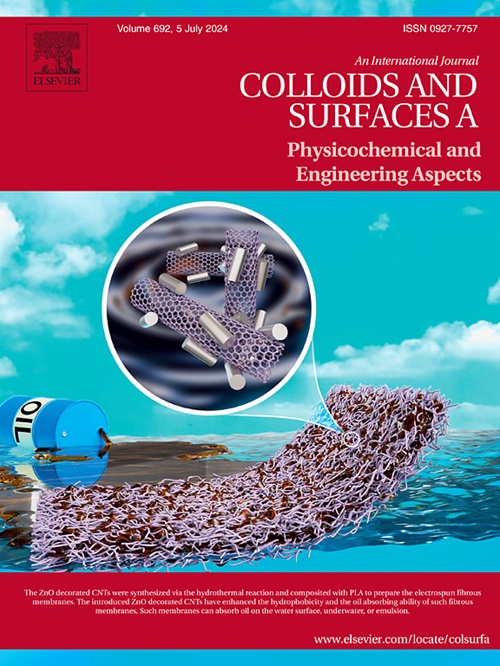协同靶向:叶酸-甘草次酸共修饰的纳米结构脂质载体增强蛇葡萄素向肝癌细胞的递送
IF 4.9
2区 化学
Q2 CHEMISTRY, PHYSICAL
Colloids and Surfaces A: Physicochemical and Engineering Aspects
Pub Date : 2025-04-26
DOI:10.1016/j.colsurfa.2025.137050
引用次数: 0
摘要
蛇葡萄素(AMP)是一种重要的类黄酮化合物,具有抗肝癌和抗肝纤维化的药理作用。然而,它在血液中的不稳定性和低生物利用度给维持有效浓度带来了挑战。为了解决这一问题,本研究开发了一种新的靶向药物递送系统:一种由甘草次酸(GA)和叶酸(FA)修饰的纳米结构脂质载体,装载AMP,称为GA/FA-AMP- nlc。该制剂利用肿瘤细胞对FA和GA的特异性识别,促进了AMP对肝脏肿瘤的主动和被动双重靶向。采用有机溶剂法制备了GA/FA-AMP-NLC,得到的GA/FA-AMP-NLC平均粒径为130.30 ± 1.83 nm,表面带负电,形貌为球形。研究脂质纳米颗粒在Hepa1-6荷瘤小鼠体内的细胞摄取和细胞活力,并分析其抗肿瘤作用和体内组织分布。MTT实验结果显示,GA/FA-AMP-NLC显著抑制HepG2细胞的生长,效果优于FA-AMP-NLC和GA- amp - nlc (p <; 0.05)。体内靶向试验和组织分布分析证实,GA/FA-AMP-NLC能有效靶向肿瘤部位,抑制肿瘤生长,同时保持良好的生物相容性。该配方通过配体连接实现了肝脏肿瘤部位的主动和被动靶向,有效地根除了肿瘤细胞,为amp靶向治疗的发展提供了一条有希望的途径。本文章由计算机程序翻译,如有差异,请以英文原文为准。
Synergistic targeting: Folate-glycyrrhetinic acid co-modified nanostructured lipid carrier enhances ampelopsin delivery to hepatic cancer cells
Ampelopsin (AMP) is a significant flavonoid compound known for its pharmacological properties, including anti-liver cancer and anti-liver fibrosis effects. However, its instability in the bloodstream and low bioavailability pose challenges in maintaining effective concentrations. To address this issue, this study developed a novel targeted drug delivery system: a nanostructured lipid carrier modified with Glycyrrhetinic acid (GA) and Folic acid (FA), loaded with AMP, termed GA/FA-AMP-NLC. This formulation leverages the specific recognition of FA and GA by tumor cells, facilitating both active and passive dual targeting of AMP to liver tumors. GA/FA-AMP-NLC was prepared using an organic solvent method, yielding particles with an average size of 130.30 ± 1.83 nm, a negatively charged surface, and a spherical morphology. The cellular uptake and cell viability of these lipid nanoparticles were examined in Hepa1–6 tumor-bearing mice, and their anti-tumor effects and in vivo tissue distribution were analyzed. Results from MTT assays indicated that GA/FA-AMP-NLC significantly inhibited the growth of HepG2 cells, demonstrating superior efficacy compared to FA-AMP-NLC and GA-AMP-NLC (p < 0.05). In vivo targeting tests and tissue distribution analyses confirmed that GA/FA-AMP-NLC effectively targets tumor sites and inhibits tumor growth while maintaining good biocompatibility. This formulation achieves both active and passive targeting of liver tumor sites via ligand connections, effectively eradicating tumor cells and offering a promising avenue for the development of AMP-targeted therapies.
求助全文
通过发布文献求助,成功后即可免费获取论文全文。
去求助
来源期刊
CiteScore
8.70
自引率
9.60%
发文量
2421
审稿时长
56 days
期刊介绍:
Colloids and Surfaces A: Physicochemical and Engineering Aspects is an international journal devoted to the science underlying applications of colloids and interfacial phenomena.
The journal aims at publishing high quality research papers featuring new materials or new insights into the role of colloid and interface science in (for example) food, energy, minerals processing, pharmaceuticals or the environment.

 求助内容:
求助内容: 应助结果提醒方式:
应助结果提醒方式:


